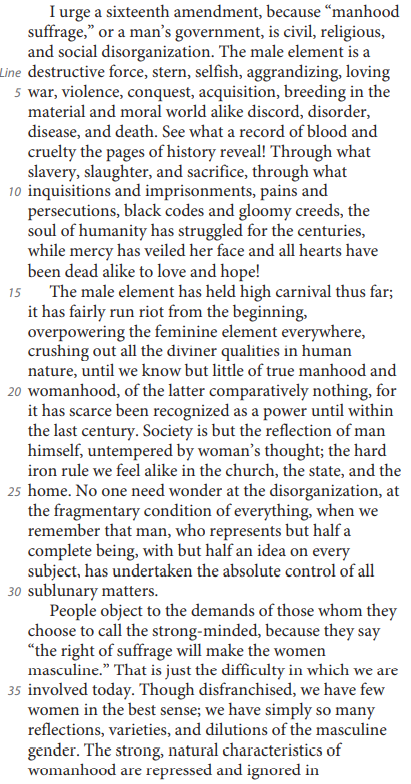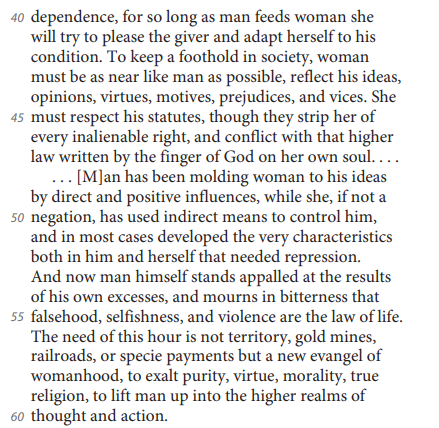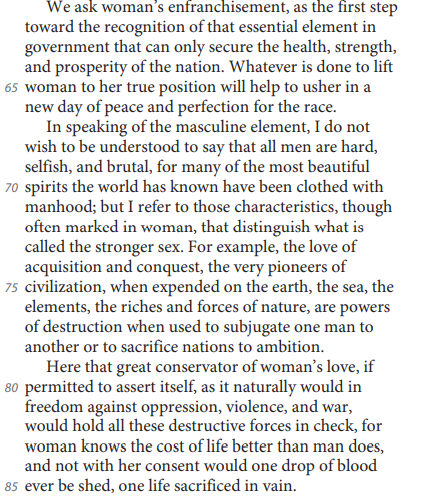SAT (Scholastic Assessment Test) is a standard test, used for taking admission to undergraduate programs of universities or colleges of the United States. SAT is developed and published by the College Board, an organization in the United States, administered by the Educational Testing Service. In this article of AKVTutorials, you will get SAT Practice Test 9 Answers | SAT 2024 Prep Online Tutor AMBiPi.
SAT Reading Practice Passage
This passage is adapted from Elizabeth Cady Stanton’s address to the 1869 Woman Suffrage Convention in Washington, DC.



SAT Reading Comprehension Practice Test Questions
SAT Practice Test 9 Question No 1
The central problem that Stanton describes in the passage is that women have been
Option A: denied equal educational opportunities, which has kept them from reaching their potential.
Option B: prevented from exerting their positive influence on men, which has led to societal breakdown.
Option C: prevented from voting, which has resulted in poor candidates winning important elections.
Option D: blocked by men from serving as legislators, which has allowed the creation of unjust laws.
SAT Practice Test 9 Answer No 1
Show/Hide Answer
Option B :
In lines 16-31, Stanton argues that men make all the decisions in “the church, the state, and the home.” This absolute power has led to a disorganized society, a “fragmentary condition of everything.” Stanton confirms this claim when she states that society needs women to “lift man up into the higher realms of thought and action” (lines 60-61).
Choices A and D are incorrect because Stanton does not focus on women’s lack of equal educational opportunities or inability to hold political positions. Choice C is incorrect because although Stanton implies women are not allowed to vote, she never mentions that “poor candidates” are winning elections.
SAT Practice Test 9 Question No 2
Stanton uses the phrase “high carnival” (line 15) mainly to emphasize what she sees as the
Option A: utter domination of women by men.
Option B: the freewheeling spirit of the age.
Option C: scandalous decline in moral values.
Option D: the growing power of women in society.
SAT Practice Test 9 Answer No 2
Show/Hide Answer
Option A :
Stanton argues that women are repressed in society because men hold “high carnival,” or have all the power, and make the rules in “the church, the state, and the home” (lines 16-31). Stanton claims that men have total control over women, “overpowering the feminine element everywhere” (line 18).
Choices B, C, and D are incorrect because Stanton does not use the term “high carnival” to emphasize that the period is freewheeling, or unrestricted; that there has been a scandalous decline in moral values; or that the power of women is growing.
SAT Practice Test 9 Question No 3
Stanton claims that which of the following was a relatively recent historical development?
Option A: The control of society by men
Option B: The spread of war and injustice
Option C: The domination of domestic life by men
Option D: The acknowledgment of women’s true character
SAT Practice Test 9 Answer No 3
Show/Hide Answer
Option D :
In lines 16-23, Stanton states that men’s absolute rule in society is “crushing out all the diviner qualities in human nature,” such that society knows very “little of true manhood and womanhood.” Stanton argues that society knows less about womanhood than manhood because womanhood has “scarce been recognized as a power until within the last century.” This statement indicates that society’s acknowledgment of “womanhood,” or women’s true character, is a fairly recent historical development.
Choices A, B, and C are incorrect because Stanton describes men’s control of society, their domination of the domestic sphere, and the prevalence of war and injustice as long-established realities.
SAT Practice Test 9 Question No 4
Which choice provides the best evidence for the answer to the previous question?
Option A: Lines 3-7 (“The male… death”)
Option B: Lines 15-22 (“The male… century”)
Option C: Lines 22-25 (“Society… home”)
Option D: Lines 48-52 (“[M]an… repression”)
SAT Practice Test 9 Answer No 4
Show/Hide Answer
Option B :
In lines 16-23, Stanton provides evidence for the claim that society’s acknowledgment of “womanhood,” or women’s true character is a fairly recent historical development: “[womanhood] has scarce been recognized as a power until within the last century.”
Choice B is incorrect because there is no evidence in the passage that Akira worries that Chie will mistake his earnestness for immaturity. Choice C is incorrect because while Akira recognizes that his unscheduled visit is a nuisance, his larger concern is that Chie will reject him due to the inappropriateness of his proposal. Choice D is incorrect because there is no evidence in the passage that Akira worries Chie will underestimate the sincerity of his emotions.
SAT Practice Test 9 Question No 5
As used in line 24, “rule” most nearly refers to
Option A: a general guideline.
Option B: a controlling force.
Option C: an established habit.
Option D: a procedural method.
SAT Practice Test 9 Answer No 5
Show/Hide Answer
Option B :
In lines 23-26, Stanton states, “Society is but the reflection of the man himself, untempered by woman’s thought; the hard iron rule we feel alike in the church, the state, and the home.” In this context, man’s “rule” in “the church, the state, and the home” means that men have a controlling force in all areas of society.
Choices A, C, and D are incorrect because in this context “rule” does not mean a general guideline, an established habit, or a procedural method.
SAT Practice Test 9 Question No 6
It can reasonably be inferred that “the strong-minded” (line 32) was a term generally intended to
Option A: praise women who fight for their long-denied rights.
Option B: identify women who demonstrate intellectual skill.
Option C: criticize women who enter male-dominated professions.
Option D: condemn women who agitate for the vote for their sex.
SAT Practice Test 9 Answer No 6
Show/Hide Answer
Option D :
In lines 32-35, Stanton argues that people use the term “the strong-minded” to refer to women who advocate for “the right to suffrage,” or the right to vote in elections. In this context, people use the term “the strong-minded” to criticize female suffragists, as they believe voting will make women too “masculine.”
Choices A and B are incorrect because Stanton does not suggest that people use the term “the strong-minded” as a compliment. Choice C is incorrect because Stanton suggests that “the strong-minded” is a term used to criticize women who want to vote, not those who enter male-dominated professions.
SAT Practice Test 9 Question No 7
As used in line 36, “best” most nearly means
Option A: superior.
Option B: excellent.
Option C: genuine.
Option D: rarest.
SAT Practice Test 9 Answer No 7
Show/Hide Answer
Option C :
In lines 36-39, Stanton states that society contains hardly any women in the “best sense,” and clarifies that too many women are “reflections, varieties, and dilutions of the masculine gender.” Stanton is suggesting that there are few “best,” or genuine, women who are not completely influenced or controlled by men.
Choices A, B, and D are incorrect because in this context “best” does not mean superior, excellent, or rarest.
SAT Practice Test 9 Question No 8
Stanton contends that the situation she describes in the passage has become so dire that even men have begun to
Option A: lament the problems they have created.
Option B: join the call for women’s suffrage.
Option C: consider women their social equals.
Option D: ask women how to improve civic life.
SAT Practice Test 9 Answer No 8
Show/Hide Answer
Option A :
In lines 54-56, Stanton argues that man “mourns,” or regrets, how his power has caused “falsehood, selfishness, and violence” to become the “law” of society. Stanton is arguing that men are lamenting, or expressing regret about, how their governance has created problems.
Choices B, C, and D are incorrect because Stanton does not suggest that men are advocating for women’s right to vote or for female equality, nor are they requesting women’s opinions about improving civic life.
SAT Practice Test 9 Question No 9
Which choice provides the best evidence for the answer to the previous question?
Option A: Lines 25-30 (“No one… matters”)
Option B: Lines 53-55 (“And now… life”)
Option C: Lines 56-60 (“The need… action”)
Option D: Lines 61-64 (“We ask… nation”)
SAT Practice Test 9 Answer No 9
Show/Hide Answer
Option B :
In lines 54-56, Stanton provides evidence that men are lamenting the problems they have created, as they recognize that their actions have caused “falsehood, selfishness, and violence [to become] the law of life.
Choices A, C, and D are incorrect because they do not provide the best evidence that men are lamenting the problems they have created. Choice A explains society’s current fragmentation. Choices C and D present Stanton’s main argument for women’s enfranchisement.
SAT Practice Test 9 Question No 10
The sixth paragraph (lines 67-78) is primarily concerned with establishing a contrast between
Option A: men and women.
Option B: the spiritual world and the material world.
Option C: bad men and good men.
Option D: men and masculine traits.
SAT Practice Test 9 Answer No 10
Show/Hide Answer
Option D :
In the sixth paragraph, Stanton differentiates between men and masculine traits. Stanton argues that masculine traits or “characteristics,” such as a “love of acquisition and conquest,” serve to “subjugate one man to another” (lines 69-80). Stanton is suggesting that some masculine traits position men within certain power structures.
Choices A and B are incorrect because the sixth paragraph does not primarily establish a contrast between men and women or between the spiritual and material worlds. Choice C is incorrect because although Stanton argues that not “all men are hard, selfish, and brutal,” she does not discuss what constitutes a “good” man.



